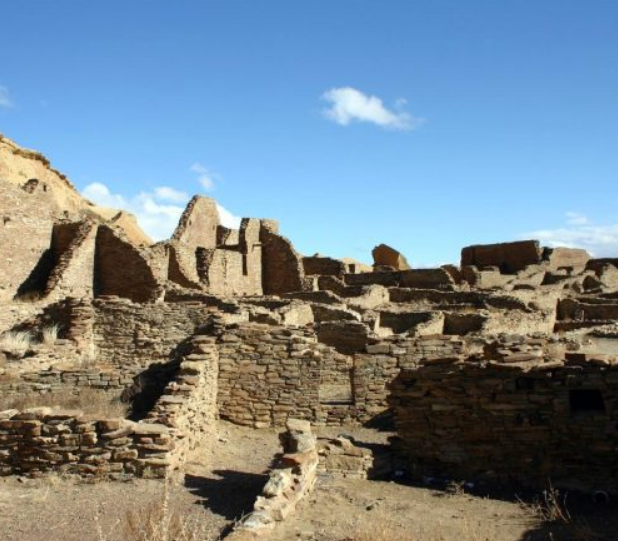
In Arizona, there lies a majestic ponderosa pine. It stands tall in what was once though to be the center of the world according to the ancestral Puebloan people. However, the tree may have more mundane origins than previously thought as research by tree-rings experts at the University of Arizona have discovered. In a study published by the journal, American Antiquity, the researchers released new data that calls into question the long-held belief that the Plaza Tree of Pueblo Bonito is the only living tree in an otherwise treeless landscape. Surrounding the tree is a regional metropolis in New Mexico’s Chaco Canyon.
The researchers of the study have combined various lines of evidence using a new process called dendroprovenance to a sample of the Plaza Tree using ring-growth patterns to trace the tree’s origin. The data revealed that the tree did not, in fact, grow where it was found. It is therefore unlikely to have played a role as significant as people have ascribed to it since its discovery in 1924.
Christopher Guiterman, the study’s first author, is an assistant research scientist at the University of Arizona’s Laboratory of Tree-Ring Research. He says that, “the tree goes back all the way to the birth of tree-ring science.” A purported ‘living tree’ growing in downtown Chaco during the height of its occupancy is unlikely. Why? Well, for one thing, it would make the tree the only one of its kind that we know of in southwestern archaeology.
Pueblo Bonito is widely considered the center of the Chaco world. The largest of the great houses is located there. The Chaco world spanned the four corners region all the way to the edge of the Colorado Plateau. Pueblo Bonito’s significance has been likened to Stonehenge in Great Britain and Machu Picchu in Pero. According to the National Park Service, Chaco’s golden era occurred from around 800 to 1100 CE, lasting a bit over 300 years.
During that time, the Chaco constructed massive stone buildings, aka great houses. These ‘great houses’ consisted of multiple stories accommodating hundreds of rooms. By 1050, Chaco became the ceremonial, administrative and economic center of the Puebolan world. Pueblo descendants still consider it a special gathering place where people shared ceremonies, traditions and knowledge.
At a 1924 dig at Pueblo Bonito, archeologists from the National Geographic Society uncovered a 20-foot pine log in the western courtyard of the great house. The discovery was pretty amazing. How? As Guiterman says, “The likelihood of finding such a tree after lying undisturbed for 800-plus years seems unbelievable, but we know that is what happened because tree rings don’t lie.”
Apparently, the tree was found underneath the present-day soil’s surface. It lay on the last utilized pavement. The trees great ‘snag-like roots’ indicated that it had never been moved, or at least archeologists thought so at the time. Researchers now know that this is not the case. Only stubs of roots, not actual roots, were found. Considering the tree doesn’t have a secure root system, that can only mean that it did not grow in Pueblo Bonito. The fact that the log was found laying flat on the top of the plaza surface also indicates that the tree grew elsewhere.
Initial analysis, done, in 1928, confirmed that the tree lived between 732 and 981. It’s possible that it could’ve lived longer since its outermost wood had eroded away over time. Guiterman has been perplexed by the tree for a long time. As he says, “You don’t just find a 1,000 year old piece of wood on the ground like that.”
To find out where the plaza tree came from, the researchers had to build a case using three lines of evidence. They looked over documentary records, which included unpublished correspondence and reports from the original archeological expeditions, strontium isotope signatures from pine trees living in the Chaco Canyon area today and tree-ring patterns that allow scientists to pinpoint the source of the wood in question. Based on this combined evidence, researchers had to conclude that the tree did not originate in Pueblo Bonito. Instead, it was probably uprooted from the Chuska Mountain range some fifty miles away. Apparently, the tree lived in the Chuska Mountains for about 250 years.
Researchers will never know for sure when it died because there’s been too much decay. However, after its death, it was taken to Pueblo Bonito. Even though the location of the tree has been determined researchers still wonder why the Puebloans would move the tree to this sacred location and how they did it. We guess that we will never know for sure.
How do you think the Puebloans got the tree from the Chuska Mountains to Pueblo Bonito? We’d love to hear your theories on our Twitter feed. Feel free to share your stories there. We welcome the conversation.











